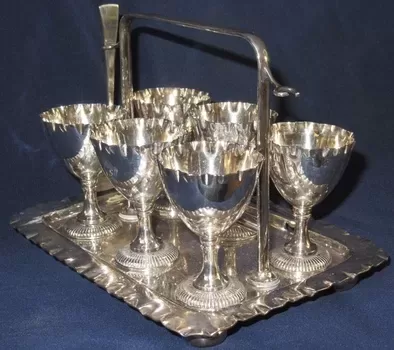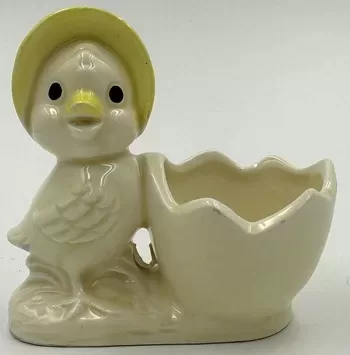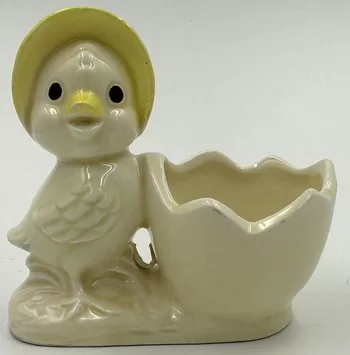Egg cups are inherently small objects and their curved surfaces are not always easy to work on, but craftsmen have managed to produce some fine decorative effects on them.
Coloured ornament has been both painted and printed onto the surface, sometimes contrasting in texture with the background.
Egg cups have been made in many materials and in a huge variety of styles; they range from exquisite pieces of craftsmanship to modern plastic novelties.
Egg cups are believed to date back to the time of the ancient Greeks, but it was not until the 18th century that they came into popular use.
Louis XV, who was King of France from 1715 to 1774, was reputed to be able to decapitate an egg with a single stroke, and this feat helped to popularize the use of egg cups.
Individual egg cups were not produced at this time, but were part of an egg cruet or egg stand. These were made in silver or Sheffield plate (which came into general use in about 1760). The frames held four, six or eight egg cups, and they came complete with matching spoons.
Sets with only three holders were intended for married couples – the husband having two eggs, the wife one – and these would have had only two spoons.
On the larger stands there was room for salt containers, butter and preserve holders, and occasionally toast-racks. These were known as compendiums and could hold as many as 12 eggs.
By the beginning of the 19th century, egg cruets were also being made in pottery and porcelain, often matching the pattern of the breakfast or tea china. Individual egg cups also now appeared.
Early china examples were usually of a goblet-like shape with a fine stem; they were fragile and easily broken, so they are rare today.
Bucket-shaped egg cups, however, appeared at much the same time; the Wedgwood factory was making them by 1802. Glass egg cups appeared in the 1830s and various plastics were used from the 1920s.
Search eBay for Vintage egg cups




(left) Walker & Hall Silver Plate 6 Fluted Rim Egg Cup Set; (right) 1950s made in Japan
Double ended eggs cups
There were numerous variations on the standard cup format. Double-ended cups with one cup larger than the other were intended to hold a hen’s egg in the smaller end and a duck or goose egg in the larger.
Another popular type was the egg ring or hoop; these look rather like waisted napkin rings and in fact are often mistaken for them today.
Victorian and Edwardian breakfasts were heartier meals than they are today, and eggs were often cooked at the table using an egg boiler.
The domed silver or silver-plated container with its removable lid was set on a spirit burner; eggs were carefully placed onto the interior frame and cooked for the required number of minutes.
Egg cup collector’s notes
Egg cups have been made in such vast quantities and in so many styles that it might be as well to decide whether you are going to collect over the whole range or specialize in a particular material, a particular manufacturer or a particular type (novelty egg cups or commemorative ones, for instance).
Ceramic egg cups were made by every major manufacturer, as well as many lesser known factories, and the famous names – such as Derby or Coalport – command high prices.
Twentieth-century egg cups will generally be much cheaper, with the exception of those by top designers such as Clarice Cliff.
Certain types of egg cup are also usually pricey either because they are rare or because they are particular favourites of collectors. Souvenir egg cups, for example, are plentiful, but commemorative issues are much less common.
The material also has a great effect on the price, with silver egg cups at one end of the scale obviously costing a lot more than plastic ones at the other end.
As with other antiques and collectables, the presence of makers’ marks (or hallmarks on silver) will add to the value of egg cups, just damage will lower the price.
Any enamelling or gilding should be bright and not rubbed and you should check for chips or cracks china or glass and splits in wood (wooden egg cups are difficult to date, so experience needed before investing in anything expensive).
If you are buying egg stands or cruet check that the various components match and are not a ‘marriage’.
These stands and cruets are bulky are sometimes difficult to display, but one of the attractions of egg cups is that they are small and easy to arrange into whatever kind of display pleases you.
Clear pressed glass egg cups can be rather boring when grouped together but the more expensive coloured or opalescent glass ones look most attractive in a group.
Recommended:
Egg Cups: An Illustrated History and Price Guide by Brenda C. Blake
In Victorian and Edwardian times, breakfast was often a lengthy business, and it could be some distance from the kitchen to the dining room or breakfast room, so a good deal of ingenuity was devoted to serving food hot. Examples exist of silver plated egg boilers which would have been placed on the table or sideboard. The burner used methylated spirits.
Egg Cup Supplement and Price Guide 2000 by Brenda Blake
The Joy of Collecting Egg Cups by Javad Hashemi
Egg Cups: An Illustrated History and Price Guide by Brenda C. Blake
More Kitchen Collectibles
Are Salt and Pepper Shakers collectible What to look for
What to collect in Vintage & Antique Cruet Sets
Collecting and Caring for Apothecary Bottles
V&A acquires rare Wedgwood tea & coffee set from Karl Lagerfeld estate





